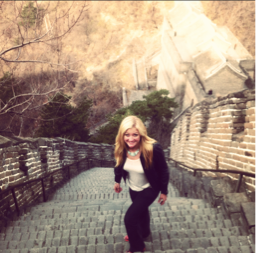72 Hours in China
- thebrieadventure

- Dec 17, 2017
- 5 min read

There are some amazing trips where you do not need to have everything planned out. Trips where having more flexibility allows you to meet extraordinary new people who may have just discovered a mysterious hidden temple in the jungle and they invite you to trek to it with them for a once in a lifetime adventure. China is not that trip. When I discovered that China offers a 72-hour transit visa to encourage tourism during long layovers, I jumped on the opportunity. By design, this was to be a quick stop that would allow me to avoid visa hassles, efficiently visit all the major tourist spots, and make it back to the airport in the strict 72-hour limit. Since the primary purpose of my visit to China was just to hit the iconic sites for this trip, so the transit visa was an excellent option. Since it was still a fairly new choice when I visited in 2014, the border entry guards were very unfamiliar with the regulations which meant that I spent several hours stuck in the border entry line arguing with the officials in the airport. Eventually, after sufficiently demonstrating that I had departure tickets and met all of the requirements listed directly on their official website, the guards stamped my passport and let me through. Unfortunately, since the entry process took several hours, I had missed the final train going into town and had difficulty finding anyone to help me locate a different method of transit.
As I struggled to find a bus or taxi, I quickly realized just how restricted the internet was in China as the searches on my iphone came back blocked or were not translated into English. Eventually, I found a bus sign that listed the same name as the train stop I was supposed to get off at. I crossed my fingers and bought a ticket. Turns out it was the same stop and finally I made it all the way into downtown Beijing. However, I misread the sign and got off the bus a stop too early. Luckily a kind local man saw me wandering around muttering unintelligibly at my map and gave me directions to my hostel.
Due to the visa entrance issues, I ended up missing the first afternoon and evening on my itinerary, further limiting the condensed plan. That being said I found that it was still possible to visit Tiananmen Square, the Forbidden City, the Silk Market, try roasted duck and lots of food cart delicacies, as well as spending a full day on the Great Wall of China. Starting at 5 am the first day, I did an early morning visit of Tiananmen Square and the Forbidden City which were right beside the hostel. At that early hour both were nearly empty of the tourists’ crowds. Almost all of the main tourist spots are within walking distance of each other with the assistance of a clear map! For the sake of saving time and ensuring I caught my flight the next evening, I opted to hire a driver for the day ($100) when going out to the Great Wall in order to maximize the time I could spend actually exploring on it. While it is possible to use public buses to get out to sections of the Great Wall, they are notoriously slow and difficult to get a seat on and with the language barrier I wanted to avoid the hassle all together.
While there are hordes of tourists visiting each day, the Great Wall is so massive that it is still possible at certain points I still found myself completely alone and had several moments to soak in this mammoth landmark. There are numerous sections that are open to visitors but based on photographs I had seen and articles I had read before going, I selected the Mutianyu area because it is less touristy. It did not disappoint! Mutianyu received excellent reviews for being mostly restored, with frequent towers, great vantage points, and easy access from Beijing with only a 1 ½ to 2-hour drive. Upon arriving, I was happy to see that the ticket counter and the whole entrance area were clearly marked in English making it easy to navigate. There were several options offered for accessing the Wall including hiking, cable cars, or a toboggan, as well as an abundance of restaurants, bathrooms, and souvenir shops at the bottom.
After taking the cable car up, I hiked up the seemingly endless stairs towards the Dajiao Building. While I would never recommend breaking the rules, there is a non-tourist area leading off from the tower, so if following trail signs is not a strong suit of yours, this off-limits area offers the advantage of complete silence and an unbelievable view of the mountains and Wall. It is a bit cumbersome to climb the stairs because none of them are the same height or width, but the frequent towers in this section make for excellent rest stops. I visited in late October and would certainly recommend going in the autumn because it was comfortably cool weather and not overrun with tourists.

Must do: Ride the luge down the mountain after walking the Great Wall. When the ticket lady offered the luge as a return option I immediately scoffed, writing it off as a tourist trap. But my friend was so excited about it that I felt obligated and reluctantly agreed. It was marvelous. Sometimes I forget how exciting (read unsafe) that dull activities are in other countries which do not have the same safety precautions and restrictions. We careened down the mountain on the luge, with only one man monitoring our speed about halfway down who only managed to yell an admonishment as we sped past. We crossed a high bridge with remarkable view of the valley below, flew around some hairpin turns, and found the experience to be much more amusing than it looked from the chair lift above. The entrance fee is 45 RMB (about $6.50) and the chair lift/luge is separate at 60 RMB (about $9.50) each.
Avoid: Hassle in the airport. The transit visa is a great way to avoid the cost and difficulty of getting a visa, but it can be quite problematic to get through customs lines upon arrival since there is no physical visa in your passport. Be sure to have printed documents proving proof of time of arrival and onward travel within the 72-hour mark, as well as the information about the transit visa. Even with all of the paperwork it was difficult to get through, so be prepared for long lines. For specific information concerning the caveats of the transit visa, check out:
Hostel Average Cost: $20
Currency: Renminbi which also known as Yuan
Drink: Baiju- this popular clear liquor is served at most restaurants, is even available in most convenience stores, and is actually the most widely consumed spirit in the world.
Food: Peking duck. This was surprisingly a bit challenging to find, but the famous dish met all expectations!
Electric Outlet: American- Type A and European-Type C
Visa: Generally required, or no visa for the 72 hour transit














Comments